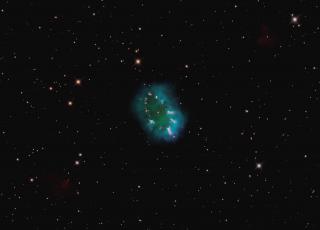Bibcode
Wesson, R.; Jones, D.; García-Rojas, J.; Boffin, H. M. J.; Corradi, R. L. M.
Bibliographical reference
Monthly Notices of the Royal Astronomical Society, Volume 480, Issue 4, p.4589-4613
Advertised on:
11
2018
Citations
77
Refereed citations
67
Description
It has recently been noted that there seems to be a strong correlation
between planetary nebulae with close binary central stars and highly
enhanced recombination line abundances. We present new deep spectra of
seven objects known to have close binary central stars, and find that
the heavy element abundances derived from recombination lines exceed
those from collisionally excited lines by factors of 5-95, placing
several of these nebulae among the most extreme known abundance
discrepancies. This study nearly doubles the number of nebulae known to
have a binary central star and an extreme abundance discrepancy. A
statistical analysis of all nebulae with measured recombination line
abundances reveals no link between central star surface chemistry and
nebular abundance discrepancy, but a clear link between binarity and the
abundance discrepancy, as well as an anticorrelation between abundance
discrepancies and nebular electron densities: all nebulae with a binary
central star with a period of less than 1.15 d have an abundance
discrepancy factor exceeding 10, and an electron density less than
˜1000 cm-3; those with longer period binaries have
abundance discrepancy factors less than 10 and much higher electron
densities. We find that [O II] density diagnostic lines can be strongly
enhanced by recombination excitation, while [S II] lines are not. These
findings give weight to the idea that extreme abundance discrepancies
are caused by a nova-like eruption from the central star system,
occuring soon after the common-envelope phase, which ejects material
depleted in hydrogen, and enhanced in CNONe but not in third-row
elements.
Related projects

Bipolar Nebulae
This project has three major objectives: 1) To determine the physico-chemical characteristics of bipolar planetary nebulae and symbiotic nebulae, to help understanding the origin of bipolarity and to test theoretical models, mainly models with binary central stars, aimed at explaining the observed morphology and kinematics. 2) To study the low
Antonio
Mampaso Recio
![Izquierda - Imagen RGB de la nebulosa de Orión y M43 obtenida filtros estrechos con la cámara WFC en el INT: H alfa (rojo), [S II] 6716+30 (verde), [O III] 5007 (azul). Derecha - Imagen en falso color de la nebulosa planetaria NGC 6778. En azul se ve la emisión en la línea de O II tomada con el filtro sintonizable azul del instrumento OSIRIS en el GTC; en verde imagen con el filtro estrecho de [O III] del Nordic Optical Telescope (NOT). Izquierda - Imagen RGB de la nebulosa de Orión y M43 obtenida filtros estrechos con la cámara WFC en el INT: H alfa (rojo), [S II] 6716+30 (verde), [O III] 5007 (azul). Derecha - Imagen en falso color de la nebulosa planetaria NGC 6778. En azul se ve la emisión en la línea de O II tomada con el filtro sintonizable azul del instrumento OSIRIS en el GTC; en verde imagen con el filtro estrecho de [O III] del Nordic Optical Telescope (NOT).](/sites/default/files/styles/crop_square_2_2_to_320px/public/images/project/imagen_web.jpg?itok=fsBmV9CO)
Physics of Ionized Nebulae
The research that is being carried out by the group can be condensed into two main lines: 1) Study of the structure, dynamics, physical conditions and chemical evolution of Galactic and extragalactic ionized nebulae through detailed analysis and modelization of their spectra. Investigation of chemical composition gradients along the disk of our
Jorge
García Rojas